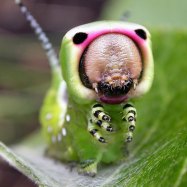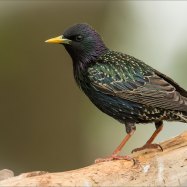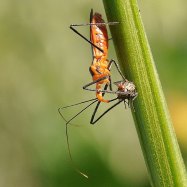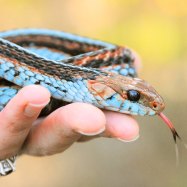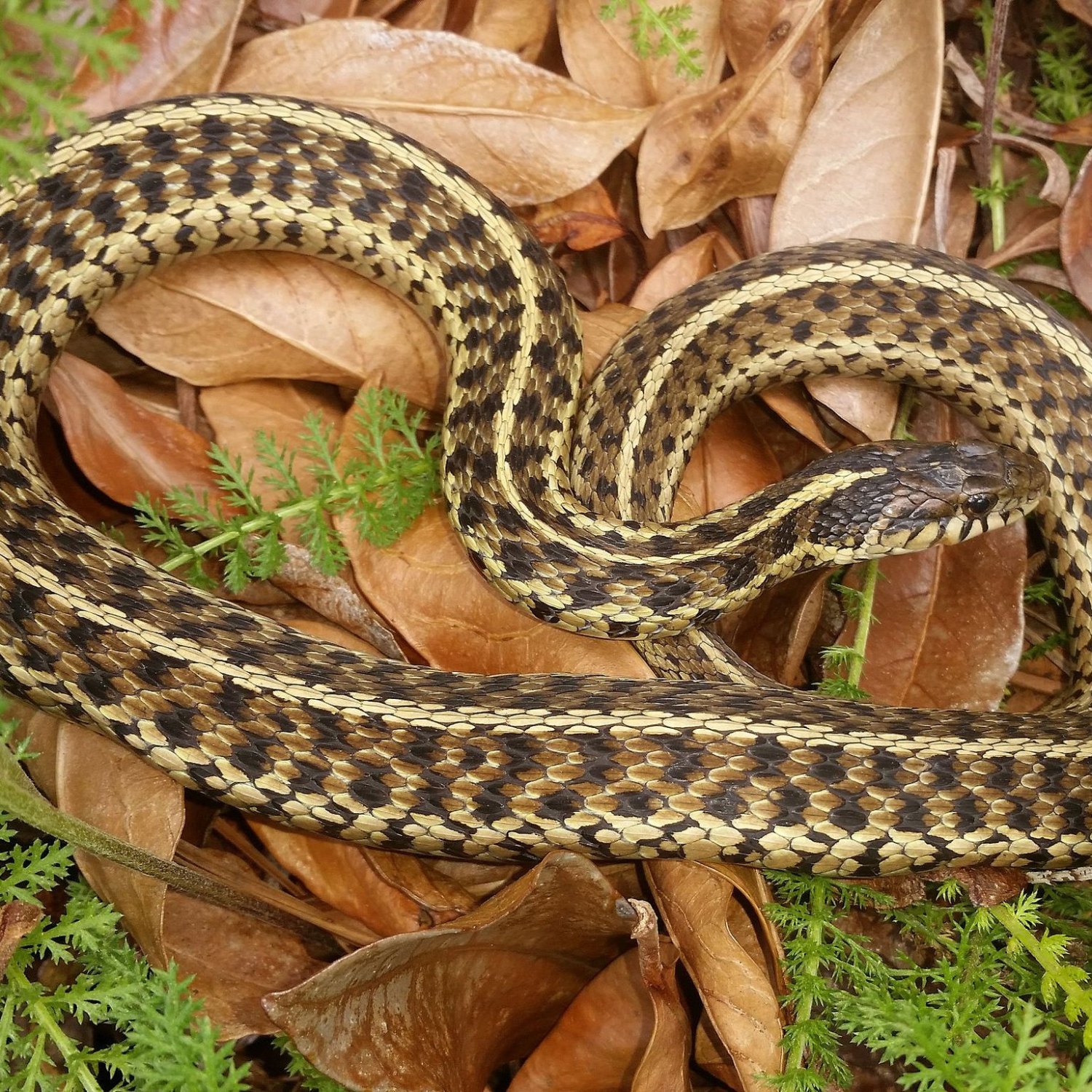
Garter Snake
20-48 inches
Garter snakes are fascinating creatures found all across North America. With their slender and elongated bodies, these members of the Colubridae family can grow up to 20-48 inches in length. They can be found in a variety of habitats, from grasslands to forests. Next time you come across a garter snake, admire its beauty and remember to keep a safe distance.
Animal Details Summary:
Common Name: Garter Snake
Kingdom: Animalia
Habitat: Grasslands, fields, meadows, forests, wetlands
The Incredible Garter Snake: A Serpent of Diversity
From the fields of the United States to the forests of North America, one reptile stands out with its vibrant colors and slender figure. The garter snake, scientifically known as Thamnophis sirtalis, is a common yet fascinating creature that thrives in various habitats, making it one of the most adaptable snakes in the world.As you delve deeper into the world of the garter snake, you'll discover its incredible attributes and how it has continued to capture the interest of many over the years. So let's slither our way into this article and unravel the diverse nature of this serpent Garter Snake.
Origin and Taxonomy
The garter snake is a species that belongs to the Animalia kingdom and the Chordata phylum. It falls under the class Reptilia, which includes all reptiles, such as lizards, turtles, and crocodiles. This snake is part of the order Squamata, which consists of scaled reptiles like snakes and lizards. Within this order, it is classified under the family Colubridae, which comprises over two-thirds of all snake species.There are various subspecies of garter snakes that can be found throughout North America, with the majority originating from the United States. Each subspecies has unique features that distinguish them from each other, such as color patterns and size, making them a diverse and intriguing species to study.
Habitat and Distribution
The garter snake is a versatile creature, able to adapt to various types of habitats. It is typically found in grasslands, fields, meadows, and forests, but it can also thrive in wetlands and near bodies of water like lakes and ponds. This adaptability is one of the main reasons for this snake's widespread geographical distribution Giant Golden Mole.As mentioned earlier, the garter snake is mainly found in North America, specifically in the United States. However, some subspecies can also be found in parts of Canada and Central America. Its specific location depends on the subspecies, with some being more prevalent in certain regions than others.
Carnivorous Diet
One characteristic that sets the garter snake apart from other snakes is its feeding method. While most snakes are strictly carnivores, this snake species has a varied diet. It is known to consume a wide range of prey, from small rodents, frogs, and fish to insects, slugs, and earthworms.Interestingly, the garter snake has a specialized gland that secretes a toxin that paralyzes its prey. This unique adaptation allows the snake to eat a wide range of food and hunt more effectively.
Appearance and Physical Features
The garter snake is a visually appealing creature, with a variety of colors and patterns depending on the subspecies. Some have a red or yellow stripe down their backs, while others have checkerboard-like patterns. Its body is slender and elongated, allowing it to move swiftly both on land and in the water.On average, garter snakes can grow to 20-48 inches in length, with some subspecies reaching up to 53 inches. This makes it one of the smallest snakes in North America, making it less intimidating compared to other species.
The Garter Snake, a Model for Research
Aside from its physical features and intriguing behavior, the garter snake has also caught the attention of researchers for its unique physiological traits. For instance, some subspecies have the ability to survive under extreme cold temperatures by hibernating, while others have adapted to the harsh conditions of living in brackish water.Moreover, garter snakes are also known for their courtship dances, where the males will engage in a dance-like display to attract females. This unique behavior has been studied extensively as it sheds light on the intricate mating behaviors of animals.
The Garter Snake and its Human Interactions
Despite its venomous appearance, the garter snake is harmless to humans. It is non-aggressive and will only bite as a last resort when feeling threatened. Moreover, this snake also plays a crucial role in maintaining the balance of ecosystems. With its diverse diet, it helps control the population of certain prey species, preventing overpopulation.Unfortunately, the garter snake population has been decreasing due to habitat loss, pollution, and the pet trade. As a result, some subspecies have been listed as threatened or endangered, making it essential to protect and conserve these creatures to ensure their survival.
Myths and Legends Surrounding the Garter Snake
Throughout history, snakes have always been a subject of myths, legends, and superstitions. And the garter snake is no exception. Some people believe that if you see a garter snake in your garden, it is a sign of good luck and prosperity. Others believe that if you catch a falling garter snake before it touches the ground, it can bring you good fortune.In ancient Greek and Roman mythology, the garter snake was often associated with healing and transformation. Some cultures also believe that garter snakes have the power to ward off evil spirits, thus making them a symbol of protection.
The Future of the Garter Snake
With its adaptability, unique traits, and diverse nature, the garter snake has captivated the hearts and minds of many. Its ability to thrive in different environments and its crucial role in maintaining the balance of ecosystems make it an integral part of our planet's biodiversity.However, with the increasing threats to its survival, it is essential to take proactive measures in preserving and protecting this species. As individuals, we can minimize our impact on their habitats by reducing pollution and avoiding using harmful pesticides in our gardens. We can also support conservation efforts and spread awareness about the importance of the garter snake and its role in our ecosystem.
In Conclusion
The garter snake may be one of the most common snake species in North America, but its adaptability, diversity, and unique characteristics make it a fascinating creature. From its striking appearance to its interesting physiological traits, it continues to captivate the interest of many, making it a crucial subject for research and conservation efforts.Let us appreciate the incredible garter snake and ensure its survival for future generations to marvel at its magnificence.

Garter Snake
Animal Details Garter Snake - Scientific Name: Thamnophis sirtalis
- Category: Animals G
- Scientific Name: Thamnophis sirtalis
- Common Name: Garter Snake
- Kingdom: Animalia
- Phylum: Chordata
- Class: Reptilia
- Order: Squamata
- Family: Colubridae
- Habitat: Grasslands, fields, meadows, forests, wetlands
- Feeding Method: Carnivorous
- Geographical Distribution: North America
- Country of Origin: United States
- Location: Varies depending on species
- Animal Coloration: Varies depending on species
- Body Shape: Slender and elongated
- Length: 20-48 inches
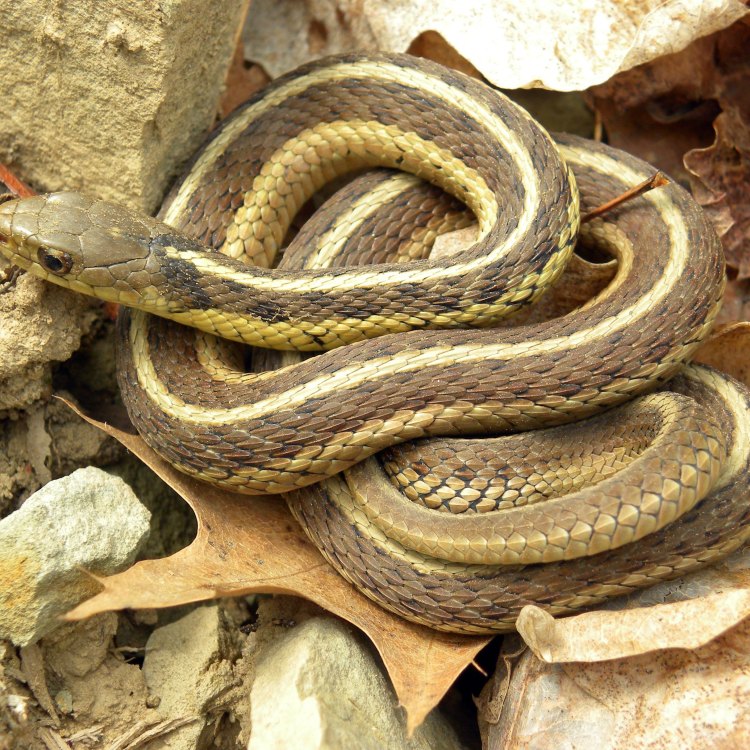
Garter Snake
- Adult Size: Up to 4 feet
- Average Lifespan: 6-10 years
- Reproduction: Oviparous
- Reproductive Behavior: Mating occurs in spring and the female gives live birth to 10-80 young snakes
- Sound or Call: Do not produce vocal sounds
- Migration Pattern: Some species exhibit seasonal migrations
- Social Groups: Solitary
- Behavior: Semi-aquatic and diurnal
- Threats: Habitat loss, road mortality, predation
- Conservation Status: Least Concern
- Impact on Ecosystem: Help control populations of prey species
- Human Use: Popular as pets and in the reptile trade
- Distinctive Features: Distinct longitudinal stripes on the body
- Interesting Facts: Garter snakes are mildly venomous, but their venom is not harmful to humans
- Predator: Birds, larger snakes, mammals
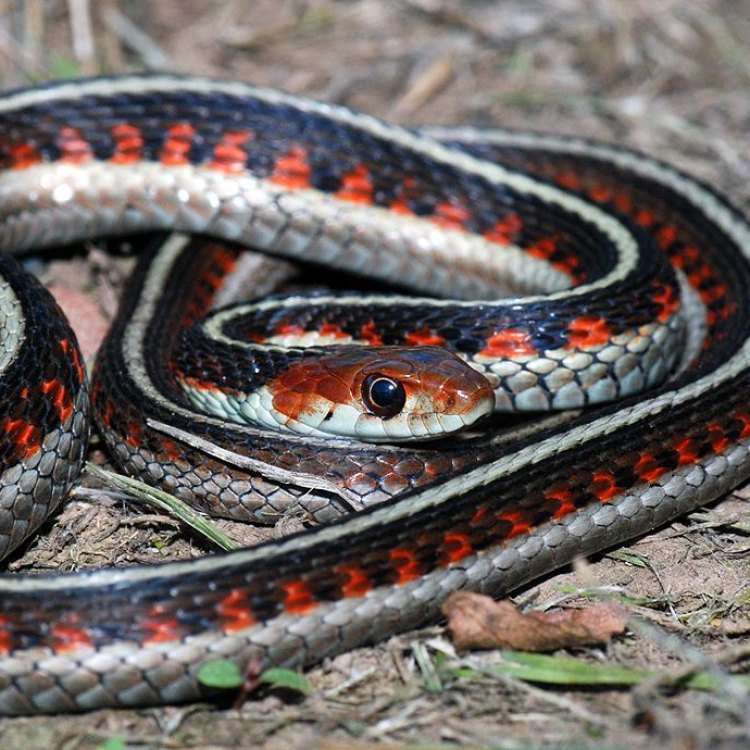
Thamnophis sirtalis
Garter Snakes: The Fascinating and Misunderstood Reptiles
The Garter Snake, also known as the garden snake, is a common sight in many parts of North America. These fascinating creatures belong to the family Colubridae and can be found in a variety of habitats, ranging from forests and grasslands to wetlands and even urban gardens.But despite their ubiquity, there is still much to be discovered about these slithering friends. From their unique reproductive behavior to their role in the ecosystem, there is so much more to garter snakes than meets the eye PeaceOfAnimals.Com. In this article, we will delve into the intriguing world of these reptiles and learn about their distinctive features, interesting facts, and crucial role in maintaining a healthy ecosystem.
The Basics of Garter Snakes
Before we dive into the more exciting aspects of garter snakes, let us first understand some basic information about them. These reptiles typically grow up to four feet in length, making them one of the smaller species of snakes. They have an average lifespan of 6-10 years in the wild, but can live up to 20 years in captivity.Garter snakes are oviparous, which means they lay eggs rather than giving birth to live young. However, unlike most oviparous snakes, garter snakes also exhibit a unique reproductive behavior known as "ovoviviparity." This means that while the eggs develop and hatch inside the female's body, the offspring are nourished by a yolk sac, rather than receiving nutrition from the mother through a placenta. In the spring, female garter snakes give birth to 10-80 live young, making them one of the few snake species that give live birth.
Intriguing Behaviors
In addition to their unusual reproductive behavior, garter snakes also have other fascinating traits Gentoo Penguin. Unlike some snake species that produce vocal sounds, garter snakes are silent creatures. Instead, they communicate through body language, such as flicking their tongues and posturing their bodies.Garter snakes are also semi-aquatic, meaning they spend a significant amount of time in and near bodies of water. They are diurnal, which means they are most active during the day. However, during periods of extreme heat, they may become more active in the evenings. This behavior is known as "crepuscular."
Some garter snake species, notably the red-sided garter snake, exhibit seasonal migrations. This means they travel significant distances to reach their preferred habitat for mating and hibernation. These migrations can sometimes involve hundreds of individuals, making for a remarkable sight.
Threats to Garter Snakes and Their Conservation Status
As with many other species, garter snakes face several threats to their survival. Habitat loss due to urban development and agricultural practices is one of the most significant threats to these reptiles. As more land is cleared for human use, the remaining habitat for garter snakes becomes fragmented, making it difficult for them to find food and mates.Road mortality is another major threat to garter snakes, especially during their migrations. These snakes are often hit by cars while crossing roads, resulting in many deaths and injuries. This is a particular concern for the red-sided garter snake, which has to cross highways and roads to reach its hibernation sites.
Predation is also a constant threat for garter snakes. Birds, larger snakes, and mammals such as raccoons and skunks all prey on these slithering creatures. However, garter snakes have developed some unique defense mechanisms to protect themselves. When threatened, they may release a foul-smelling musk, emit a high-pitched noise, or even mimic a venomous snake by flattening their heads.
Despite these threats, garter snakes are currently classified as "Least Concern" on the IUCN Red List of Threatened Species. While some species are experiencing population declines, they still have a widespread distribution, and their overall population appears stable.
The Crucial Role of Garter Snakes in the Ecosystem
Like all animals, garter snakes play a vital role in maintaining a balanced ecosystem. They primarily feed on small prey such as insects, earthworms, and small rodents. By consuming these species, garter snakes help control their populations, preventing them from becoming overpopulated and causing harm to the environment.Additionally, garter snakes are themselves important prey for many predators, helping to balance predator-prey relationships in their ecosystems. They also provide a food source for larger snakes, birds of prey, and mammals.
Furthermore, garter snakes also contribute to nutrient cycling in their environments. Their droppings contain essential nutrients for plants, serving as a natural fertilizer and helping to maintain healthy soil and vegetation.
Human Use of Garter Snakes
Garter snakes have long been popular pets, especially among reptile enthusiasts. Their small size, ease of care, and docile nature make them an attractive pet choice. However, it is crucial to note that garter snakes are wild animals and should not be kept as pets unless they are acquired from a reputable breeder who has not removed them from the wild. It is also essential to ensure that the necessary permits and licenses are obtained for keeping these reptiles as pets, as it is illegal to do so in many areas without proper authorization.Unfortunately, garter snakes are also a target for the illegal wildlife trade. They are often taken from the wild and sold as pets or used in traditional medicines. This practice is not only harmful to the individual snakes but can also have a negative impact on wild populations.
Distinctive Features and Interesting Facts
One of the most obvious features of garter snakes is their distinctive longitudinal stripes that run along their bodies. These stripes can be a variety of colors, including black, yellow, red, and white, depending on the species. These stripes serve as excellent camouflage, helping the snakes blend in with their surroundings to avoid predators.One of the most interesting facts about garter snakes is that they are mildly venomous. However, their venom is not harmful to humans and is not considered a threat to human health. In fact, garter snakes are popularly used in snake-handling shows due to their mild nature and low risk of harm to humans.
The Important Predators of Garter Snakes
While garter snakes may seem like apex predators due to their size and venomous nature, they too have their share of predators. As mentioned earlier, birds of prey, larger snakes, and mammals such as raccoons and skunks all prey on these reptiles. However, there is another unsuspected predator of garter snakes - the common house cat.People often keep cats as indoor pets, but these furry companions can still pose a threat to garter snakes. Cats have a natural hunting instinct, and when presented with a small, moving creature, they will often attack and sometimes kill garter snakes. This is another reason why responsible pet ownership is crucial, as keeping cats indoors can help protect not only garter snakes but other wildlife as well.
In Conclusion
In conclusion, garter snakes are fascinating reptiles with many unique features and behaviors. From their reproductive behavior to their importance in the ecosystem, these snakes play a crucial role in maintaining a healthy balance in their habitats. As we continue to learn more about these slithering creatures, it is essential to protect their habitats and dispel any misconceptions about their nature. So, the next time you see a garter snake in your garden or on a hike, take a moment to appreciate its beauty and the important role it plays in our world.
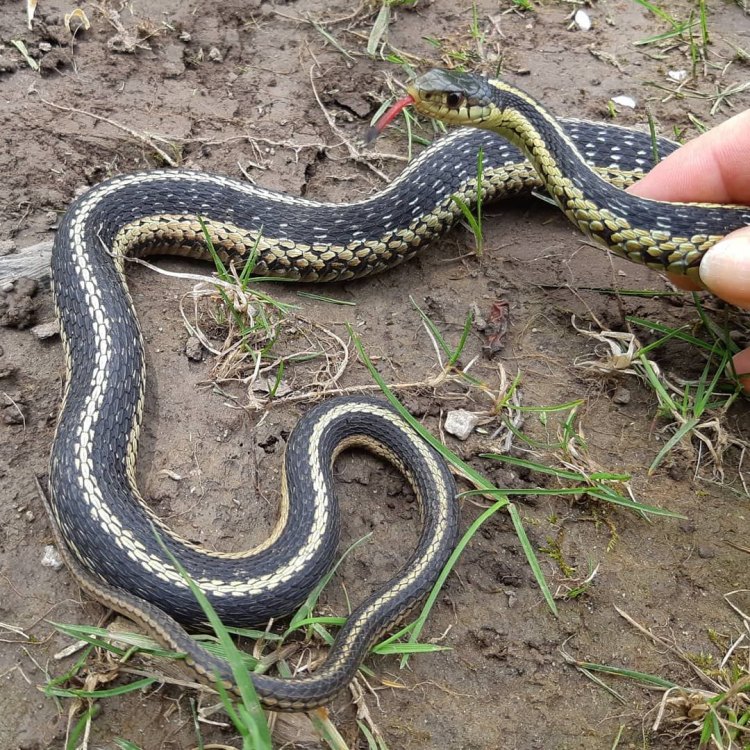
The Incredible Garter Snake: A Serpent of Diversity
Disclaimer: The content provided is for informational purposes only. We cannot guarantee the accuracy of the information on this page 100%. All information provided here may change without prior notice.

